On a beautiful sunny day, I visited with Julie Barbic in her lovely Sonoma County hilltop home. She graciously invited me into her large studio and I entered a world of fiber fantasy! There were looms everywhere, new twined rugs piled high and wonderful works in progress. I had to know how this began, so we talked over tea and goodies.
Before discovering weaving, Julie and her husband raised roses commercially. Then, in the early ’80’s , she got a loom from her aunt. As she and her husband were refurbishing it, they both became very interested and then passionate about weaving. When they moved to their current house in 1988, they decided to buy a large AVL compu-dobby in order to weave all the drapes for their new house. The house has lots of windows and they are all dressed with handwoven material. They also wove rugs, household items and clothing for themselves , as gifts and to sell. Julie is still a prolific weaver, but I wanted to know about her adventures in twining. That , too, produced a story.
She introduced herself to the twining technique after buying a kit to build a twining loom at a conference in San Jose. She learned the techniques of twining on that loom, but it was only a passing fancy, or so she thought. Then came the loom.
She had seen this very large, handmade, redwood loom at her grandson’s pre-school where it had been used by the children. After the teacher left, the school offered the loom to Julie for use by the children at her church. The children played with it for awhile, got bored, and then the church stored it away. The church was cleaning out its storage space one day when Julie was there and they offered her the loom. After moving it her studio, she started experimenting on it using the techniques she had previously developed. She was hooked! She loves twining because of the tactile feeling of working with her fingers. Her knowledge grew and she began making rugs and enjoying twining immensely. Since then, she has used this loom to make lots and lots of beautiful twined rugs from a wide variety of fabrics and colors. It must also be noted that Julie has a huge stash of fabric, enough to fill a bedroom from floor to ceiling, bequeathed to her by her mother.
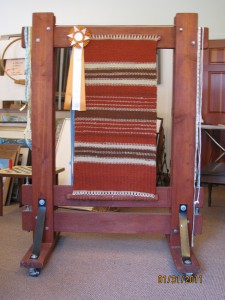
Twined rug made with heavy Dacron rug yarn. It won best Rug at the 2010 Sonoma County Fair
Even though this loom has many other uses, such as Navajo weaving, and tapestry, it is now used mainly for twining. The massive loom is a wooden frame composed of redwood planks about 6 inches wide. The loom is about 5 feet tall and four feet wide. A flat 6 inch wide plank on wheels holds up the bottom of each side of the loom. There are two rows of wooden pegs on each side of the loom. Each row is 24 inches wide, and is separated from bottom to top by 42 inches. In this way, there is room to work on two rugs at the same time.
The rug that Julie is working on now is on one side of the loom. It is made of old jeans of various fabrics and colors. Julie uses any kind of jean fabric that is available including denim, corduroy, and other lighter fabrics.
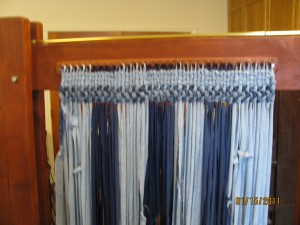
Twining loom warped and started
After she has selected and cut her jeans into 1 1/2″ inch strips, she organizes them by color, weight and design, and hangs them on a stand in groups. In this way, she always knows where to locate the pieces that she needs as she is twining. She tries to prepare enough pieces of fabric so that she won’t run out of material. The pieces are generally the same length and width, and are hand cut. She does not finish the edges of the pieces before twining. However, she said that if it is necessary, she uses fabric glue to hold pieces of slippery or loosely woven fabric together before twining.
The warp is created by joining long pieces of fabric to create the total length of fabric needed for the complete warp. The long pieces are joined by making a slit near the ends of two long pieces, and passing the other end through the slits to make a tightly joined end, and continuing this process until she has length required for the warp. Then the loom is warped top to bottom by securing one top dowel on the loom with a warp that goes around the dowel and is secured about 5 inches below the dowel. Then the warping continues top to bottom to top until the end is reached and the last dowel has been circled at the bottom. The end goes around the last dowel and is secured about 5 inches above the dowel.
Julie is working from top to bottom on the jean rug, but she said the weaver can also work from bottom to top. It is a personal choice. Some people work from top to bottom to a point, then from bottom to top, and end up by filling in the middle.
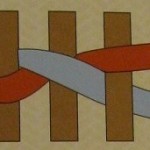
How the twining goes
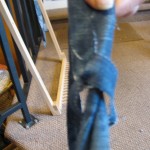
locking on the next strip
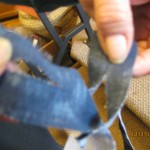
connecting strips
Then Julie decides what color of weft will start the piece and, in turn, begins the twining by using one long length of weft . The approximate middle of this strip is held against the beginning warp, and each end of this same piece is twined by passing them in front and behind each other around each warp. She secures the weft tightly with her fingers as she goes along. When the end of a length is reached, a slit is cut and a new piece is joined. (It is important to keep one of the ends longer than the other in the beginning so that when they end, the joins are not in the same place.) When the twining is finished at the last row, the last weft is secured by tucking it in with a long tapestry needle. If the weft is tightly woven, there is no need to do extra twining with another material to prevent migration of the weft toward the loops at the top or bottom. Before removing the rug from the loom, it may be necessary to trim pieces, or tuck in ends of weft. The rug is now ready to take off the loom. Julie mentioned that fabric could be washed before it is woven, but she washes the rug after it comes off the loom.
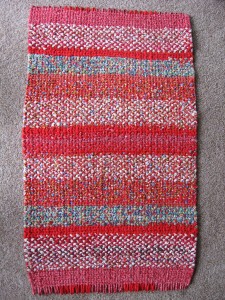
Twined rug from cotton material
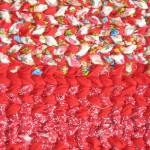
Closeup
Julie showed me several looms of various sizes from small ones for place mats, to the large twining loom that can be used for rugs. Julie mentioned that twining materials can be made from almost any fabric or material such as yarns, sewing notions, old towels, bedspreads, clothes or anything else that is in danger of being discarded. As an example, Julie showed me a lovely rug that she made from old towels and a bedspread cut into strips and twined on her large loom.
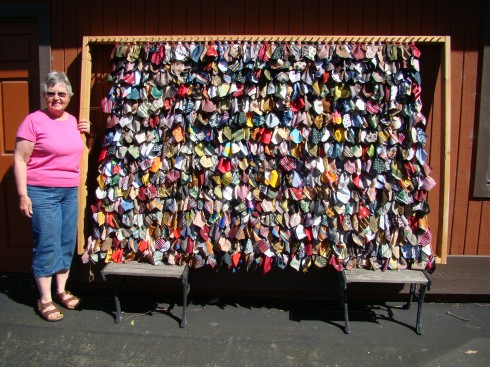
Julie and her Flying Ties Wall Hanging
A new project that Julie has recently finished is on a large 5 feet high and 8 feet long wooden frame loom. It is a unique wall hanging made from men’s old ties. She is using heavy jute yarn as warp and old ties trimmed to about 9 inches with the point on either end, as weft. She twines three inches of a heavy yarn for weft, and then she fastens each tie to a warp with a heavy thread that secures them along the row.
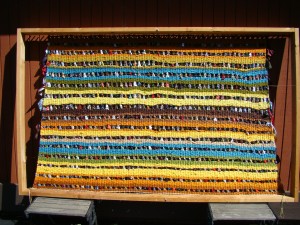
The reverse side of Flying Ties
Each tie is knotted in the manner of a traditional necktie and the point of each tie lies on top of the one below it. The effect will be a wall of rows and rows of silk ties (seated gentlemen, armor, or petals), and will be a gift to her church.
For a glimpse at another form of weaving, check out Bead Weaving